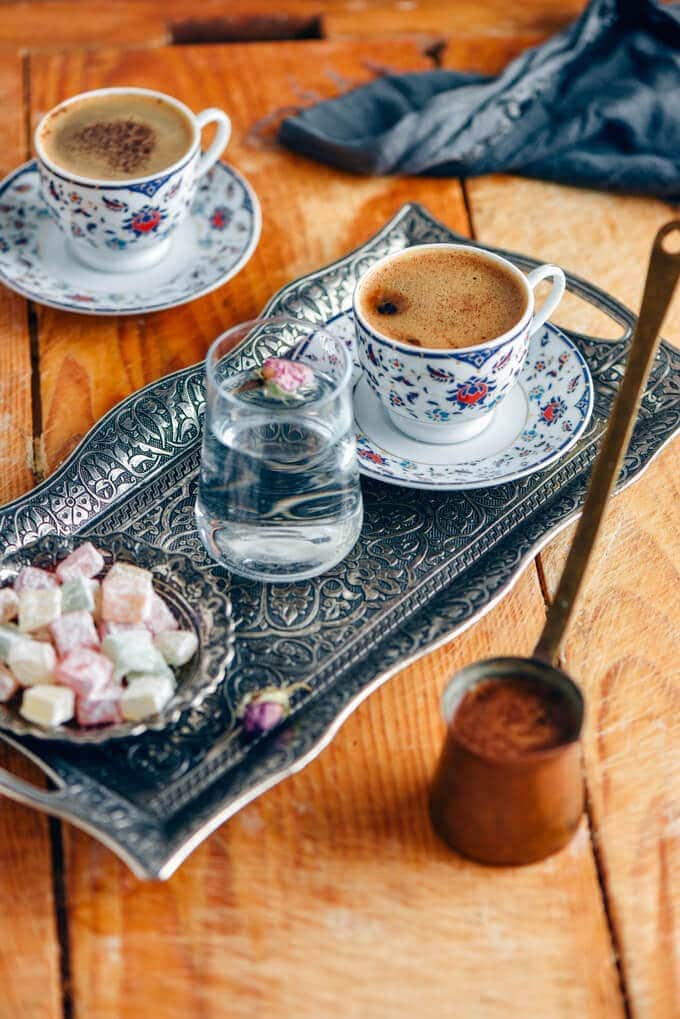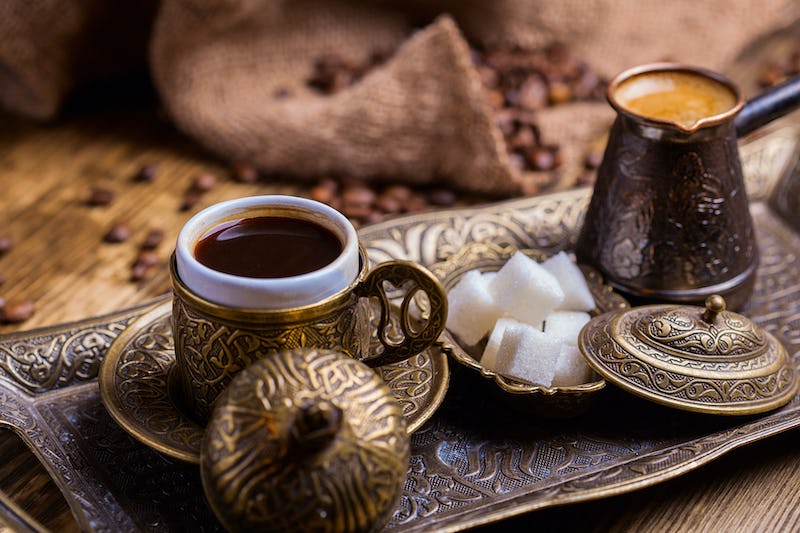The Art of Turkish Coffee
More than a popular drink, Turkish coffee is a symbol of the hospitality lived in Turkey and a hallmark of friendship. Drinking coffee with friends and family gives the opportunity to share thoughts, ideas, concerns, inspiring words, and discussions. It is also present in important social occasions like engagement ceremonies and holidays.
Even when the Turkish word kahvaltı or “after coffee” refers to breakfast, nowadays they use to enjoy it as an afternoon break or after dinner to accompany a good conversation.

Often served with a lokum —a local sweet—, the copper pot or cevze comes along with beautiful pottery or cups carved in copper and a tray, and a glass of water to clean the palate of finely grounded beans between sips.
To finish with a flourish, the grounds left in the empty cup are often used to tell a person’s fortune.
Different types of Turkish coffee are associated with a specific region of the country, such as the damla sakızlı kahve (mastic coffee), an Aegean specialty infused with the herbal, woody-flavored resin of the mastic tree.
From the Aegean coast in Manisa, you can try the cilveli kahve, which is double-roasted and topped with finely ground almonds.
If you travel south-east you will find mırra kahvesi, a dark, strong, bitter brew with origins in the Arab world; the hilve kahvesi of Hasankeyf is made with honey, walnuts, and milk; or the dibek kahvesi, which is ground in a mortar.
Part of the Intangible Cultural Heritage of Humanity by UNESCO

Turkish coffee combines special preparation and brewing techniques with a rich communal traditional culture, placing this aromatic drink on the list of Humanity’s Heritage. As UNESCO puts it: “The tradition itself is a symbol of hospitality, friendship, refinement and entertainment that permeates all walks of life.”
“Turkish coffee is regarded as part of Turkish cultural heritage: it is celebrated in literature and songs, and is an indispensable part of ceremonial occasions” adds the organization when referring to this legacy ritual.

Did you know?
• Coffee is named after Kaffa, a city in the Soha region of Ethiopia, an upland region in Africa, which is considered to be the motherland of the coffee plant and an important coffee producer.
• According to Ottoman Empire historian, Kâtip Çelebi, Sheikh Şazeli is called pir (father, master) by coffee sellers as he was the first person to boil the coffee seeds that had been given to him during a long conversation with his disciple Sheikh Ahmet while he was going on a pilgrimage in 1258 and then drank it.
• The first coffeehouse in the Ottoman Empire was opened in Istanbul in 1555 during the era of Suleiman the Magnificent. As coffee shops start to spread, they were also the main place for the dissemination of oral culture and used to offer a place for comedians and artists to perform in front of a crowd: an exhibition place for folk literature.
• The Ottoman Empire introduced coffee to the Western countries in the 16th century, being Italy as the entrance door for this drink. By the 18th century, coffee was already known throughout the world.
• Coffee is made of the fruit of the Coffea tree, from the Rubiaceae family, which origins go back to the Arabian Peninsula. But this tree grows in tropical regions that have high amounts of precipitation and no frost.
• A coffee tree may grow up to 8–10 meters; however, for production, it is allowed to grow only up to 2–3 meters. The lifespan of coffee trees is between 30 and 40 years; they start yielding fruits 3–4 years after the plantation, and it takes 8–10 months for the fruits to ripen.
• Coffee is produced in more than 60 countries —including Mexico—, but only three of them are accountable for the production of more than half of coffee in the world: Brazil, Vietnam, and Colombia.
How to prepare Turkish coffee
According to a renowned coffee company based in Trieste, Italy, Illy, the best Turkish coffee should be prepared as follows:

.
- Add water to the cezve (ibrik), about 50 milliliters (1.7 oz) per cup of coffee desired
- Add sugar to taste, stirring to blend it
- Bring to a boil, remove from heat and add a teaspoon of coffee per cup
- Boil coffee.
- Remove the cevze from heat immediately after bringing it to a first boil, discarding the accumulated foam, and mix well.
- The coffee is boiled twice in succession, taking care to remove the cezve from the heat between one boiling and the next. The foam can either be discarded or kept before stirring it well
- Allow the remaining powder to settle before serving. You can add a tablespoon of cold water to the pot after boiling twice to accelerate the process.
Enjoy a good cup of coffee today!




